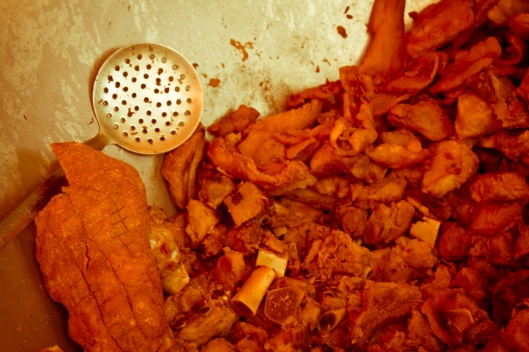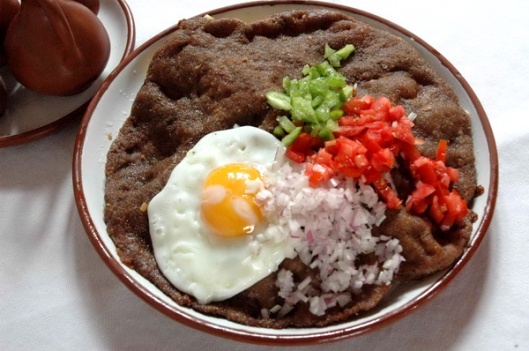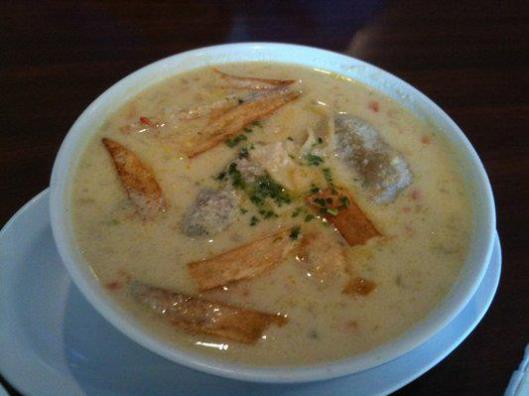Po kuchni Orientu boliwijskiego, przechodzimy do potraw tradycyjnych dla ‘Region de las Valles’ – czyli terenow polozonych na wysokosci 2000-3000 m n.p.m, w dolinach tj.: Cochababa, Sucre i Tarija. Te trzy departamenty charakteryzuja sie lagodnym klimatem w ciagu calego roku, doskonalym dla uprawy zboza, kukurydzy oraz roznych warzyw i owocow. Cochabamba slynie na przyklad z jablek i pomidorow, a region Tarija z uprawy winorosli i produkcji wina. Wino produkuje sie rowniez w Samaipacie, ktora lezy w departamencie Santa Cruz. Regiony te zamieszkale sa w wiekszosci przez ludnosc Quechua, wiele potraw ma wiec pochodzenie rodzime, co widoczne jest przede wszystkim w ich nazewnictwie (czasem trudnym do rozszyfrowania).
Cochabamba, uznawana za kulinarna stolice Boliwii, lezy mniej wiecej w samym centrum kraju. Mieszkancy La Llajta, jak sami przyznaja, zyja aby jesc. Widoczne jest to golym okiem – w tym trzecim co do wielkosci miescie Boliwii, jak grzyby po deszczu wyrastaja nowe restauracje, serwujace kuchnie i tradycyjna, i miedzynarodowa. Natomiast na popularnych mercados, mozna najesc sie do woli, za okolo 12 pesos (uwierzcie, nawet nasz portier z Santa Cruz, wspominal o tym fakcie z rozrzewnieniem). Co wiecej, podobno do kazdego dnia przypisane jest inne danie, i tak np. we wtorek wszystkie mercados w miescie serwuja ‘sopa de mani i picante de pollio’. W odroznieniu od Tierras Bajas, poszczegolne potrawy znacznie sie od siebie roznia, sa tez bardziej kolorowe.
Sucre (Chuquisaca), najpiekniejsze miasto Boliwii, slynie przede wszystkim z deserow i przepysznej czekolady, o ktorej juz kiedys pisalam. Nie jest ona najtansza – tabliczka kosztuje ok. 15 bs., ale naprawde bardzo dobra.
Tarija natomiast, posiada podobno najczystsze Mercado Central w kraju, na ktorym (jak mowia) bez obaw mozna delektowac sie niedrogim jedzeniem, popijajac je jednym z wielu regionalnych win (lub Singani). Nas jeszcze tam nie bylo (troche daleko), ale marzy nam sie weekendowy kurs wina, oferowany przez lokalne winnice.
Oto lista niektorych potraw regionow sub-andyjskich:
- Llajua: bardzo pikantny sos z locoto, pomidorow i ziolem kilkinii w Cochabambie i wakataya (Huacatay, czarna mieta) w innych miastach regionu. Podawana z kazda potrawa.
- Ch’aqi de quinua: rosol z quinoa i ziemniakami.
- Chicharrón de cerdo: kawalki miesa wieprzowego dlugo smazone we wlasnym tluszczu, podawane z bialym serem quesillo (na ktory trzeba uwazac!), kolba bialej kukurydzy, lub mote i la llajua.

- Chhanqa de conejo: gotowany zajac lub krolik, doprawiona mieta i zielona cebulka, podawana z fasola, ziemniakami, Chuño (totalnie wysuszone ziemniaki) i locoto.
- Cuy: Pieczona lub gotowana swinka morska. Czasem zamiast swinki morskiej uzywa sie kurczaka:)

Fot. Wikipedia.
- Enrollado: kiełbasa wieprzowa z przyprawami, podawane z marynowanymi warzywami (cebula, papryka).
- Escabeche de patitas de cerdo = marynowane swinskie nogi.
- Habas pejtu: kawalki suchego miesa, z bialymi ziemniakami, podsmazana cebula i aji (pikantne papryczki).
- Humitas: pasta z maczki kukurydzianej, gotowana w sakiewkach z lisci kukurydzy, nadziewana serem (w Santa Cruz nazywana tamal).

Fot. Wikipedia
- Jak’alawa: bulion ze skorek wieprzowych, z kukurydza i ziemniakami.
- Jauri uchu: rosół z mięsa króliczego, wołowiny i baraniny, z ziemniakami, jajkiem, papryczka aji (uchu) i zielona cebulka. Podaje sie tradycyjnie w dniu pogrzebu.
- K’allu: salatka z grubo krojonych pomidorow, cebuli i locoto.
- Pique macho: czyli danie z resztek – mieszanka wolowiny lub innego miesa, kielbasek (a raczej parowek), pomidorow, jajek, frytek, locoto (stad nazwa – pikantny). Poany sosem z musztardy, ketchupu i majonezu. Bardzo popularne w barach i pubach, szczegolnie ze wzgledu na ogromne porcje! Danie powstalo w restauracji Miraflores w Cochabambie, ktora przypomina zawsze pelen hangar fabryczny. Restauracja ta jest troche droga, zwazywszy na jej skromny wyglad i serwis.

Fot. Wikipedia.
- Pulpito frito: smazony wolowy zoladek z bialymi ziemniakami lub bulionem z nerek.
- Sillp’anchu (silpancho): cienki kotlet wolowy, smazony w panierce, podawany ze smazonymi ziemniakami, ryzem, jajkiem i salatka z pomidorow, cebuli i locoto. O tym popularnym i smacznym daniu pisalam wczesniej.

Fot. Wikipedia.
- Trancapecho: kanapka z silpancho.
- Chorizos chuquisaqueños: slynne kielbaski z Sucre, podawane z chlebem, maslem, salatka z salaty, pomidora, cebuli i locoto.
- Chanfaina: gulasz z krwi i miesa jagniecego, z ziemniakami.
- Charque – suche kawalki miesa z mote, ziemniakami w lupinach, jajkiem, podane z locoto i llayua.

Fot. Wikipedia.
- Empanadas y saltenas: pieczone pierozki z miesnym nadzieniem z warzywami. Trzeba na nie uwazac, poniewaz czasem przygotowuje sie je z resztek nieswiezego miesa i duzo osob sie po nich rozchorowalo. Ja za nimi nie przepadam.

Fot. Wikipedia.
- Picante de pollo: kawalki kurczaka, gotowane w sosie wlasnym z cebula, colorante (czerwonym barwnikiem i przyprawa w jednym), groszkiem, podawane z ryzem i makaronem. Jedno z moich ulubionych dan – bez makaronu:)

- Chirriadas: cienkie nalesniki smazone na goracym kamieniu.
- Sopa de mani: zupa z orzeszkow ziemnych, z ziemniakami, marchewka, makaronem i frytkami. Pycha! Choc mocno rozgotowany makaron i rozmoczone frytki raczej do siebie nie pasuja. Czasem mozna spotkac krem ‘sopa de mani’. Polecam!

Fot. Wikipedia.
- Surubi, trucha – ryby rzeczne.
- Falso conejo – jak sama nazwa wskazuje, zamiast zajaca, uzywa sie w tej potrawie innego miesa, zwykle wolowego.
- Aji de lengua – jezor wolowy, gotowany w pikantnym sosie wlasnym z cebula, pomidorami, pietruszka, podawany z ryzem i salatka warzywna. Smakuje i pachnie dobrze, ale wygladem nie zacheca, szczegolnie jezeli gotuje sie jezory ze skorka i w calosci…
Desery (postres) i napoje (bebidas):
- Misk’iq’eta (Arrope): deser z maki kukurydzianej i cukru, jeden ze skladnikow chicha.
- Chicha cochabambina: napoj alkoholowy uzyskiwany z fermentacji kukurydzy (takie niskoprocentowe piwo kukurydziane). O chicha mozna by pisac dlugo i szeroko, jako ze kazdy region ma wlasnu przepis. Jezeli ktos chce sprobowac, to tylko ze sprawdzonego zrodla, bo to troche jak z naszym rodzimym bimbrem – nigdy nic nie wiadomo. Ja ‘zostalam zmuszona’ do wypicia miseczki na potancowce w Torotoro (taki to juz zwyczaj, ze pani domu czestuje gosci chicha z wiaderka) i po kilku lykach bylo mi juz niedobrze. Slyszalam, ze niekiedy do jej przygotowania uzywa sie brudnej wody, oraz, zeby szybciej fermontowalo, przezutych i wyplutych ziaren kukurydzy. Smacznego!
- Garapiña: podobna do chicha, ale zmieszana z lodami cynamonowymi, kremem z kokosa i sporadycznie z truskawkami. Chicha nie zawsze jest napojem alkoholowym.
- Ajenjo: alkohol pity w czasie karnawalu.
- Mistelas: likier z owocow zanurzonych w alkoholu.
- Singani: brandy produkowana w okolicach Tarija. Narodowy alkohol Boliwii.
- Te de canela – herbatka z dlugo gotowanych lasek cynamonu. Pyszna!
Zrodla: www.cocinaboliviana.com, Wikipedia, doswiadczenie wlasne.
***
After the Bolivian Orient cuisine, it’s time for traditional dishes of ” Region de las Valles ‘ – that is, areas located at an altitude of 2000-3000 meters above sea level in the valleys, ie. Cochababa, Sucre and Tarija. These three departments are characterized by a mild climate throughout the year, perfect for growing cereals, corn and various vegetables and fruit. For example, Cochabamba is famous for its apples and tomatoes, and Tarija for vineyards. The wine is also produced in Samaipata, which lies in the department of Santa Cruz. These regions are mostly inhabited by Quechua population, therefore many dishes are of indigenous origin, which is evident primarily in their terminology (sometimes difficult to decipher).
Cochabamba, considered the culinary capital of Bolivia, is located roughly in the center of the country. Residents of La Llajta, confess that they live to eat. This can be seen with a naked eye – in the third largest city of Bolivia, like mushrooms sprout new restaurants, serving traditional and international cuisine. What’s more, in the popular mercados, you can ‘eat like a pig’ for about 12 pesos (trust me, even our porter from Santa Cruz has recalled this fact with sentiment). Also, different dish is assigned to each day, and so for example, on Tuesday all mercados in the city serve ‘sopa de mani and picante de pollio. In contrast to the Tierras Bajas, traditional dishes of las Valles are significantly different from each other and they are more colorful.
Sucre (Chuquisaca), Bolivia’s most beautiful city , is famous especially for its delicious desserts and chocolate, which I wrote about before. It’s not the cheapest – bar costs about 15 bs., but it’s worth it.
Tarija, has apparently the cleanest Mercado Central (Central Market) in the country, where (as they say) you don’t need to worry about bacterias enjoying affordable food with a glass of the many regional wines (or Singani). We weren’t there yet, (it’ s a bit far away), but we dream of a weekend’s wine course organised by local wineries.
Here’s a list of some tipical food of sub- Andean region:
■ Llajua : very spicy sauce made of locoto, tomatoes and herb of kilkinia in Cochabamba and wakataya (Huacatay or black mint) in other cities. Served with each dish.

■ Ch’aqi de quinua : broth with quinoa and potatoes.
■ Chicharrón de cerdo : long pieces of pork fried in its own fat, served with white cheese quesillo (be careful!) , a whole white corn or mote and la llajua.

■ Chhanqa de conejo: cooked bunny or rabbit, seasoned with mint and green onions, served with beans, potatoes, chuño ( totally dehydrated potatos) and locoto.
■ Cuy : Baked or boiled guinea pig . Sometimes, instead of guinea pigs, chicken is being used :)
■ Enrollado : pork sausage with spices, served with marinated vegetables (onions, peppers).
■ Escabeche de patitas de cerdo = pickled pig’s feet .
■ Habas pejtu : pieces of dry meat, with white potatoes , fried onions and aji (spicy peppers).
■ Humitas : pasta with corn meal, cooked in pouches from the leaves of corn, stuffed with cheese (in Santa Cruz called tamal) .
■ Jak’alawa : broth with pork skins , with corn and potatoes.
■ Jauri ear : chicken soup with rabbit meat , beef and/or mutton, with potatoes, egg, aji and green onions. Is traditionally eaten on the day of the funeral.
■ K’allu : coarsely chopped salad with tomatoes , onions and locoto .
■ Pique macho : that is, a dish of leftovers – a mixture of beef or other meats, sausages, tomato , eggs , french fries, locoto (hence the name – spicy). Poured with ketchup, mayo and mustard sauce. Very popular in bars and pubs, because of its big portion. The “Pique Macho” was created by Mr. Honorato Quinones and his wife Evangelina Gomez Quinones, owners of “Restaurante Miraflores” in Cochabamba, that reminds of huge hangar, always full of customers and quite pricey for its look and service.
■ Pulpito frito : fried beef stomach with white potatoes and broth from the kidneys .
■ Sillp’anchu (silpancho : thin beef cutlet , fried in batter, served with fried potatoes, rice, egg and salad with tomatoes, onions and locoto . I wrote about it earlier.
■ Trancapecho : silpancho sandwich.
■ Chorizos chuquisaqueños : famous sausages from Sucre served with bread, butter, salad with lettuce, tomato, onion and locoto.
■ Chanfaina :stew of lamb blood and meat with potatoes.
■ Empanadas y Saltenas : baked dumplings stuffed with meat and vegetables. One needs to watch out, because sometimes they are prepared from the remaining, old meat and a lot of people got sick after eating them. I do not like them myself.
■ Picante de pollo : chicken pieces cooked in gravy with onions, colorante (red dye and flavoring in one) , peas , served with rice and noodles One of my favorite dishes – without the pasta:)
■ Chirriadas : thin pancakes fried on a hot stone.
■ Sopa de mani : soup made with crushed peanuts, with potatoes, carrots, pasta and french fries. Yum! Although I don’t like overcooked pasta and soggy fries. Sometimes you can taste cream of ‘sopa de mani’ . Recommended!
■ Surubi , trucha – river fish .
■ Falso Conejo – as the name suggests , instead of the rabbit , they use different meat, usually beef .
■ Aji de lengua – beef tongue, cooked in a spicy gravy with onions, tomatoes, parsley, served with rice and vegetable salad. Tastes and smells good, but its look isn’t very appetizing, especially if it’s cooked whole and with the skin…
Desserts (postres) and drinks (bebidas):
■ Misk’iq’eta (Arrope) : dessert with corn flour and sugar, one of the ingredients of chicha.
■ Chicha cochabambina : alcoholic beverage obtained from the fermentation of corn (maize beer) . I could write long and wide about it , as every region has its own recipe. If someone wants to try it , it’s reccomended to get it from a trusted source, because it’s a bit like our Polish ‘bimber’ – you never know what it is . Once, I ‘was forced’ to drink the cup of chicha at the party in Torotoro (it is a tradition, that the lady of the house treats visitors with chicha from the bucket), and after a few sips I was already sick. I’ve heard that sometimes it’s produced with dirty water and for faster fermontation, the corn is chewed and split in a mix . Enjoy!
■ Garapin : similar to chicha, but mixed with cinnamon ice-cream, cream of coconut and occasionally with strawberries. Chicha is not always an alcoholic beverage .
■ Ajenjo : alcohol drunk during the carnival .
■ Mistelas : a liqueur with fruit dipped in alcohol.
■ Singani – brandy produced in Tarija . National beverage of Bolivia.
- Te de canela – ‘tea’ made by boiling cinnamon sticks. Love it!
Sources: www.cocinaboliviana.com, Wikipedia, own experience.














